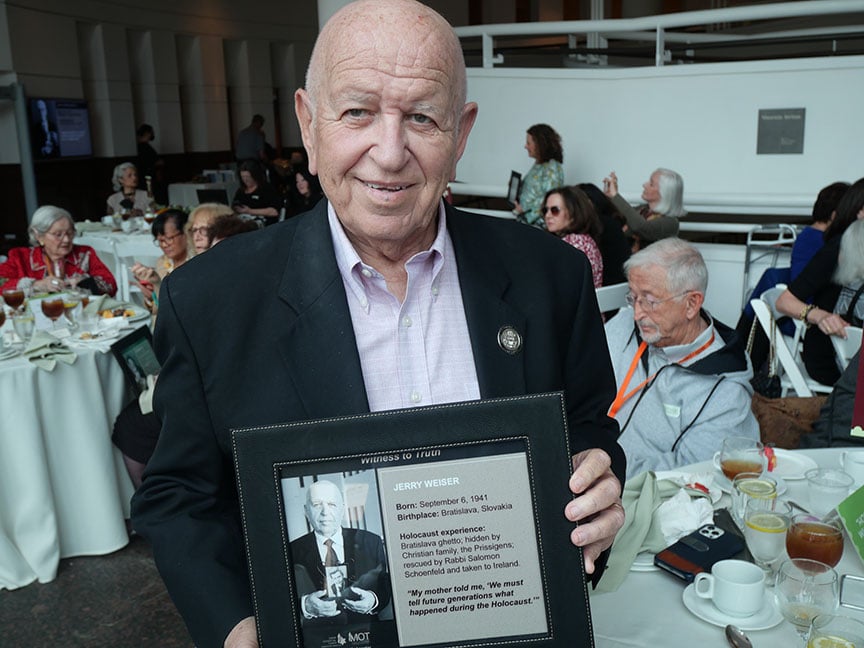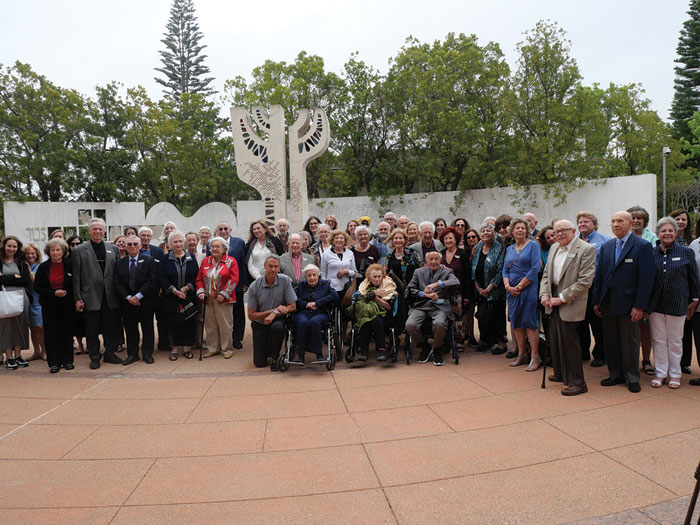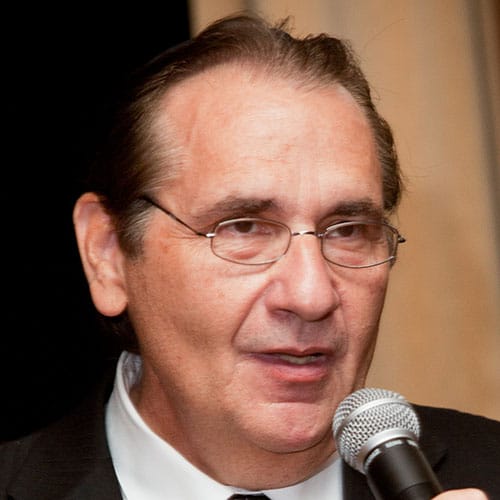
In 2005, Marissa Roth, a Pulitzer-prize winning photojournalist, approached Simon Wiesenthal Center (SWC) Director, Museum Volunteer Services Elana Samuels, and Liebe Geft, director, Museum of Tolerance (MOT), to pitch a photographic project. Roth proposed creating a gallery of Holocaust survivor portraits that would line the museum’s lobby atrium. While there was no budget for such an endeavor, Samuels and her husband Zachary felt passionately that the project had to move forward, and they wrote the first check.
Geft, with husband Dr. Ivor Geft, wrote the second check as additional support flowed in. Fifteen years in the making (accounting for a two-year setback due to COVID-19), with a number of photo sessions over the years, the Witness to Truth Portrait Gallery was completed and dedicated on May 19, International Holocaust Remembrance Day. The gallery is a collection of 104 black-and-white portraits of Holocaust survivors.
Dedication ceremonies were attended by 28 SWC MOT Holocaust survivors as well as family members representing 13 survivors who have passed. Samuels presided over the ceremonies with Geft and Rabbi Marvin Hier, founder and CEO of the SWC, delivering remarks.
Those whose portraits are featured in the gallery were active SWC volunteers at one time. “Some greeted the public; others were tour guides; most were speakers sharing their Holocaust experiences with students,” Samuels said. “One survivor worked in the library and archives. All were very proud to be a part of the museum, sharing their message of hope and tolerance, and preserving the memory of the Holocaust.”

During COVID, the gallery went up online, and survivors hosted weekly virtual live Holocaust survivor webinars that are heard by people around the globe.
“With 100 testimonies recorded, last year the virtual zoom presentations reached more than 100,000 listeners in every corner of the world,” said Samuels.
Addressing his remarks to the survivors in attendance, Hier said, “It is up to you, who know first and foremost, what it means to go through a Holocaust, who have stepped forward in history. All of you here today, who we honor, who went on to rebuild Jewish life. To build Jewish institutions of learning to return to the Promised Land. That today there is a state of Israel, and so to you, we can’t thank you enough for what you have done for all of the Jewish people.”
Hier then turned his remarks to contemporary world events: “Here we are a mere 80 years later and look how many haters, how many bigots, how many antisemites, have infested our world here in the U.S., in North America and in Europe,” he said. “Look at Putin and Ukraine, the Ayatollahs of Iran who deny the Holocaust and are developing nuclear weapons. We know who the first customer of their nuclear weapons will be. It will be the State of Israel.”
Among the attendees were Amrom Deutsch, 97, who was born in a small town between Romania and Hungary. “In 1944 on the last day of Pesach they came to the house,” he said.
Among the attendees were Amrom Deutsch, 97, who was born in a small town between Romania and Hungary. “In 1944 on the last day of Pesach they came to the house,” Deutsch, whose portrait is featured in the gallery, said. “We had nothing to steal. We lived a normal and poor life. We didn’t know who they were or what they wanted.”
Deutsch’s family consisted of 11 members, with nine surviving the Holocaust. After being imprisoned in a ghetto, he was taken to Auschwitz and eventually to Bergen-Belsen until he was liberated.
Also in attendance was Jerry Weiser, 80, who described himself as a hidden child. “My mother smuggled me out of the [modern day] Bratislava, Slovakia ghetto. I ended up in Ireland and I actually was raised as a Christian. I went through a number of religions until I was reunited with my mother in Israel, where I became an Orthodox Jew.”

Weiser’s mother never spoke about the Holocaust. “But she told me that in 100 years nobody will remember that the Holocaust even happened,” he said. “I decided I had to tell the story, so I became a volunteer at the Simon Wiesenthal Center.”
With the passing of time, 42 Holocaust survivors from the Witness Gallery remain alive today. Many are very frail, in the hospital or care facilities and were unable to attend the event in person.
With the passing of time, 42 Holocaust survivors from the Witness Gallery remain alive today. Many are very frail, in the hospital or care facilities and were unable to attend the event in person.
In addition to the Witness to Truth Gallery, in 2011 Samuels started The Legacy Project. The Legacy Project consists of video interviews with Holocaust survivors with the goal to create a library of testimonies to be used in the MOT for educational programs and for public visitors. So far, 30 survivors’ stories have been captured on video. Tragically, 19 of the original 30 survivors have already passed away leaving only five still able to share their stories.
With the gathering of Holocaust survivors and their descendants in the SWC auditorium, mixed emotions filled the room. The Witness to Truth exhibit portrays the human faces of the survivors. It personalizes that the Holocaust was not a mere statistic of six million Jews murdered, but also of people who survived.
One of the questions often asked is how many survivors remain to tell their stories. Answers vary and are difficult to pinpoint.
“I do not know the number of Holocaust Survivors alive today,” Samuels said. “However, I am very aware of the fragility of life. They are the most precious and dwindling asset. Holocaust survivors are my role models and mentors, and it is for that reason that I am so passionate about the Witness to Truth Portrait Gallery and Legacy Project.”























 More news and opinions than at a Shabbat dinner, right in your inbox.
More news and opinions than at a Shabbat dinner, right in your inbox.